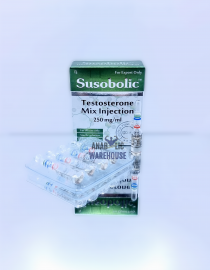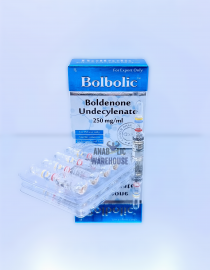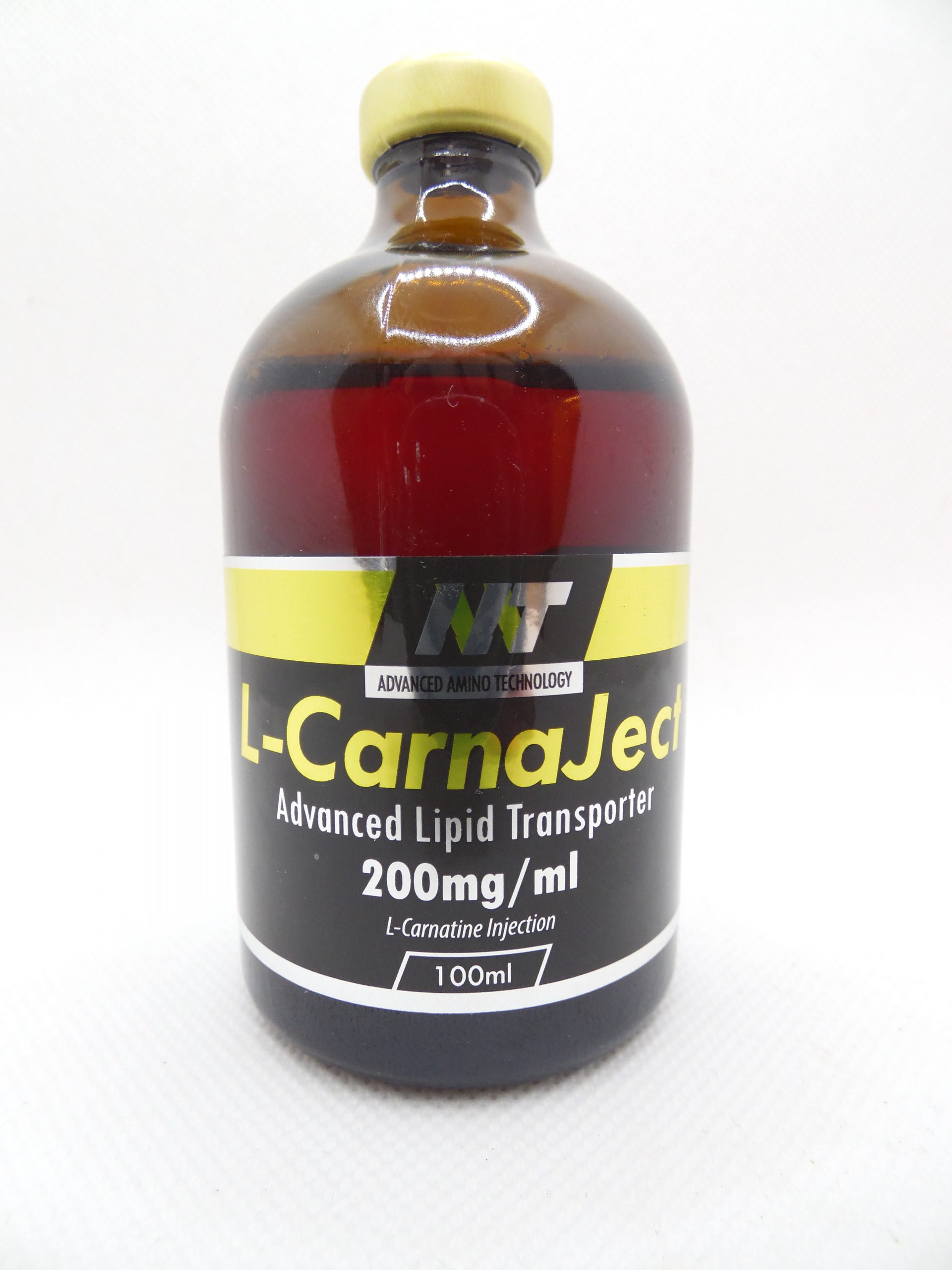- You have no items in your shopping cart
- Continue Shopping
L-Carnitine Injection (Cyanocobalamin) 200mg – Advanced Amino Technology
R430.00
- Strength

- Muscle Gain

- Fat/Water Loss

- Side Effects

- Keep Gains

Dosage: 1 ml per 25kg body weight / day
Chemical Name: Cyanocobalamin
Quantity: 100ml vial
Product may differ from picture
General Information
Levocarnitine (L-3-hydroxy-4-N-trimethylaminobutyrate) is synthesized in the liver from the amino acids methionine and lysine. This naturally occurring substance is found in all mammalian tissues, especially striated muscle, and is required in energy metabolism, such as the oxidation of fatty acids, facilitating the aerobic metabolism of carbohydrates, and enhancing the excretion of certain organic acids. While only the L isomer is present in the biologic system, commercial synthesis of carnitine produces a D,L racemic mixture, from which the L-isomer is obtained. The D-isomer has pharmacologic effects but does not participate in lipid metabolism. Commercially, carnitine is available as both a prescription and non-prescription product. The prescription version is levocarnitine, while most dietary supplements contain D,L-carnitine which is commonly sold in health food stores.
Levocarnitine has been used in the treatment of primary and secondary carnitine deficiency in adults and neonates, Alzheimer’s disease, dilated cardiomyopathy in adults and children, valproic acid-induced hepatotoxicity in children, and hyperlipoproteinemia. It has been designated an orphan drug for a variety of conditions. Its use in alcohol induced fatty liver, Down’s syndrome, and chronic fatigue syndrome has shown varying results. Some athletes use carnitine supplements to increase exercise performance, however, the concept of carnitine loading does not appear to be very effective.1 Further, D,L-carnitine competitively inhibits levocarnitine. This inhibition may lead to a deficiency. Prescription forms of levocarnitine were approved by the FDA in 1985 (tablets), 1986 (oral solution), and 1992 (injection).
Mechanism of Action
Levocarnitine facilitates long-chain fatty acid transport from the cytosol to the mitochondria, providing substrates for oxidation and subsequent cellular energy production. Levocarnitine can promote the excretion of excess organic or fatty acids in patients with defects in fatty acid metabolism or specific organic acidopathies that bioaccumulate acyl CoA esters. Levocarnitine clears the acyl CoA esters by formation of acylcarnitine which is rapidly excreted.
Carnitine acetyltransferases (CATs) catalyze the interconversion of fatty acid esters of coenzyme A and carnitine, which are located in the cytosol and mitochondrial membranes. Translocases, which exist in mitochondrial membranes, rapidly transport both free carnitine and its esters in and out of cells. Fatty acid esters of CoA, formed in the cytosol, inhibit enzymes of the Krebs cycle, and are involved in oxidative phosphorylation. Hence, the oxidation of fatty acids requires the formation of acylcarnitines and their translocation into mitochondria where the CoA esters are reformed and metabolized. If oxygen tension is limited, carnitine serves to maintain a ratio of free to esterified CoA within mitochondria that is optimal for oxidative phosphorylation and for the consumption of acetyl CoA.
Pharmacokinetics
Levocarnitine can be administered orally or intravenously. Levocarnitine is not bound to plasma proteins including albumin.
If plasma carnitine concentrations exceed the renal reabsorption maximum (roughly 60—100 µmol/L), excess carnitine is eliminated in the urine. Carnitine supplementation appears to have little, if any, affect on muscle carnitine content in humans. Carnitine in the central compartment does distribute into tissue, however, muscle is particularly refractory to acute supplementation because of its slower net turnover.1 After administration of large doses of carnitine, most of the dose is rapidly recovered in the urine. Levocarnitine is hepatically metabolized, with the major metabolite, trimethylamine N-oxide, excreted primarily in the urine (8—49%). Urinary excretion of carnitine is 4—8% of the total administered dose. Fecal excretion of total carnitine is < 1% of total carnitine excretion.
Special Populations:
Renal Impairment: Pharmacokinetic and clinical studies have shown that administration of levocarnitine to patients with end-stage renal disease (ESRD) on hemodialysis results in increased plasma levocarnitine concentrations. The safety and efficacy of oral levocarnitine has not been evaluated in patients with renal insufficiency. Chronic administration of high doses of oral levocarnitine in patients with severe renal impairment or in ESRD patients on dialysis may result in accumulation of the potentially toxic metabolites, trimethylamine (TMA) and trimethylamine-N-oxide (TMAO), since these metabolites are normally excreted in the urine. The accumulation of these metabolites does not occur to the same extent following intravenous administration (manufacturer information).
Indications/Dosage
For the treatment of primary systemic carnitine deficiency or for acute and chronic treatment of patients with an inborn error of metabolism that results in secondary carnitine deficiency:
NOTE: Levocarnitine is designated an an orphan drug by the FDA for this indication.
Intravenous dosage: Adults, Adolescents and Children: The recommended dose is 50 mg/kg IV given as a slow 2 to 3 minute bolus injection or by infusion. Often a loading dose is given to those with severe metabolic crisis, followed by an equivalent dose over the following 24 hours. Per the manufacturer literature, it should be administered every 3 to 4 hours, and never less than every 6 hours. All subsequent daily doses are recommended to be in the range of 50 mg/kg/day IV or as therapy may require. The highest dose administered has been 300 mg/kg. Monitoring should include blood chemistries, plasma carnitine (the plasma free carnitine concentration should be between 35 to 60 micromol/L) and overall clinical condition.
For the prevention and treatment of carnitine deficiency in patients with end stage renal impairment who are undergoing dialysis:
NOTE: Levocarnitine is designated an an orphan drug by the FDA for this indication.
Intravenous dosage: Adults: The recommended starting dose is 10 to 20 mg/kg dry body weight IV as a slow 2 to 3 minute bolus injection into the venous return line after each dialysis session. Initiation of therapy may be prompted by trough (pre-dialysis) plasma levocarnitine concentrations that are below normal (40 to 50 micromol/L). Dose adjustment should be guided by trough (pre-dialysis) levocarnitine levels, and downward dose adjustments (e.g., to 5 mg/kg after dialysis) may be made as early as the third or fourth week of therapy. NOTE: Do NOT use oral formulations for this indication.
Patients with Renal Impairment Dosing:
The IV formulation of this drug is acceptable for use in patients with end-stage renal disease (ESRD) on dialysis; no dosage adjustments are needed (see specific indication above). NOTE: Do NOT use oral (PO) levocarnitine to treat patients with severe renal impairment or ESRD. Major metabolites formed during oral administration following chronic high oral dosage may accumulate (manufacturer information, see Precautions).
Administration Information:
Intravenous (IV) Injection: Levocarnitine should be given as a slow 2—3 minute bolus injection or by continuous infusion. Parenteral admixtures of levocarnitine in sodium chloride 0.9% or Lactated Ringers solution, with concentrations ranging from 0.5—8 mg/ml, are stable for 24 hours at room temperature in PVC plastic bags.
Contraindications/Precautions
Levocarnitine may cause gastrointestinal symptoms and should be used conservatively in patients with diarrhea.
Levocarnitine is classified as pregnancy category B. Reproductive studies have been performed in rats and rabbits at doses up to 3.8 times the human dose and have reported no evidence of impaired fertility or harm to the fetus. No adequate, well controlled studies exist in pregnant women. This drug should be used during pregnancy only if clearly needed.23
Levocarnitine therapy has been associated with an increased seizure activity. It should be administered with caution to patients with a history of a seizure disorder.
Although levocarnitine is used in the treatment of some types of cardiomyopathy, it should be administered with caution to patients with a history of cardiac disease or cardiac dysfunction. Various cardiovascular adverse effects have been reported with the administration of intravenous levocarnitine in dialysis patients, including hypertension, peripheral edema, and ventricular arrhythmias.
Peripheral neuropathy may be potentiated by levocarnitine administration.
The safety and efficacy of oral levocarnitine has not been evaluated in the setting of renal impairment. Do not use oral formulations of levocarnitine to treat patients with severe renal impairment or renal failure, including patients on dialysis. The major metabolites formed following chronic oral administration, trimethylamine [TMA] and trimethylamine-N-oxide [TMAO] will accumulate in patients with renal failure since they can not be efficiently removed by the kidneys (manufacturer information). The accumulation of these potentially toxic metabolites is not desirable since it increases the amount of nitrogenous waste to be removed in the dialysis procedure. In addition, increased levels of TMA in dialysis patients have been reported to be associated with possible neurophysiologic effects. The inefficient removal of these metabolites may result in the development of a “fishy” body odor. Only the intravenous form of levocarnitine is indicated for use in ESRD patients on hemodialysis; accumulation of metabolites does not occur to the same extent following intravenous administration of levocarnitine.
Use levocarnitine with caution in hepatic disease since no specific information is available.
Supplementation with levocarnitine in women who are breast-feeding has not been specifically studied; however, levocarnitine is a normal component of human milk which is required for fat metabolism. Consumption of levocarnitine within the normal range of dietary intake leads to excretion into the breast-milk, which is relatively constant. Women with carnitine deficiency and preterm infants may require prescription levocarnitine supplementation under the supervision of a healthcare professional. It is unlikely that maternal levocarnitine supplements during nursing would be harmful to the infant, but it is probably best to avoid over-the-counter supplementation until more data is available. Levocarnitine has been studied in dairy cows; data indicate that the concentration of levocarnitine in milk is increased following exogenous administration of levocarnitine. In nursing mothers receiving levocarnitine, any risks to the child of excess carnitine intake need to be weighed against the benefits of levocarnitine supplementation to the mother. Consideration may be given to discontinuation of nursing or of levocarnitine treatment.
Side Effects
Gastrointestinal (GI) adverse effects are possible with oral and intravenous (IV) levocarnitine therapy. These GI symptoms include abdominal pain, dyspepsia, diarrhea, gastritis, nausea, and vomiting. These adverse effects with oral therapy may be reduced by slowing the rate of consumption and administering as divided doses throughout the day. During clinical trials of IV levocarnitine in patients on chronic hemodialysis, GI adverse reactions were reported at the following incidence compared to placebo: abdominal pain (5—21% vs 17%), anorexia (3—6% vs 3%), constipation (3% vs 6%), diarrhea (9—35% vs 19%), dyspepsia (5—9% vs 10%), gastrointestinal disorder (2—6% vs 2%), melena (2—6% vs 3%), nausea (5—12% vs 10%), vomiting (9—21% vs 16%), weight gain (2—3% vs 2%), and weight loss (3—8% vs 3%).23
Drug-induced body odor (described as “fishy” odor), headache, paresthesias and weakness have been associated with intravenous as well as oral administration of levocarnitine. During clinical trials of IV levocarnitine in patients on chronic hemodialysis, nervous system adverse reactions were reported at the following incidence compared to placebo: headache (3—37% vs 16%), anxiety (1—2% vs 5%), asthenia (8—12% vs 8%), depression (5—6% vs 3%), dizziness (10—18% vs 11%), drug dependence (2—6% vs 2%), hypertonia (1—3% vs 5%), insomnia (3—6% vs 6%), paresthesias (3—12% vs 3%), and vertigo (2—6% vs 0%).23
Levocarnitine therapy has been associated with seizures in patients with and without a history of seizures and an increase in seizure activity (frequency and/or severity). It should be administered with caution to patients with a history of seizures.23
During clinical trials of IV levocarnatine in patients on chronic hemodialysis, cardiovascular adverse reactions were reported at the following incidence compared to placebo: arrhythmia (2—3% vs 5%), atrial fibrillation (2—6% vs 0%), cardiovascular disorder (3—6% vs 6%), abnormal electrocardiogram (3—6% vs 0%), bleeding (2—9% vs 6%), chest pain (unspecified) (6—15% vs 14%), hypertension (18—21% vs 14%), hypotension (3—19% vs 19%), palpitations (3—8% vs 0%), peripheral edema (3—6% vs 3%), sinus tachycardia (5—9% vs 5%), and vascular disorder (2—6% vs 2%).2
During clinical trials of IV levocarnatine in patients on chronic hemodialysis, respiratory and infectious adverse reactions were reported at the following incidence compared to placebo: infection (10—24% vs 17%), fever (5—12% vs 5%), bronchitis (3—5% vs 0%), cough (9—18% vs 16%), dyspnea (3—11% vs 19%), pharyngitis (15—27% vs 33%), rhinitis (6—11% vs 10%), and sinusitis (2—3% vs 5%).2
During clinical trials of IV levocarnitine in patients on chronic hemodialysis, general adverse reactions were reported at the following incidence compared to placebo: anemia (3—12% vs 3%), injection site reaction (27—38% vs 59%), rash (unspecified) (3—5% vs 3%), pruritus (3—8% vs 13%), dysgeusia (2—9% vs 0%), amblyopia (3—6% vs 2%), eye disorder (3—6% vs 3%), back pain (6—9% vs 10%), parathyroid disorder (2—6% vs 2%), hypervolemia (3—12% vs 17%), hyperkalemia (6% vs 6%), and hypercalcemia (6—15% vs 3%).




